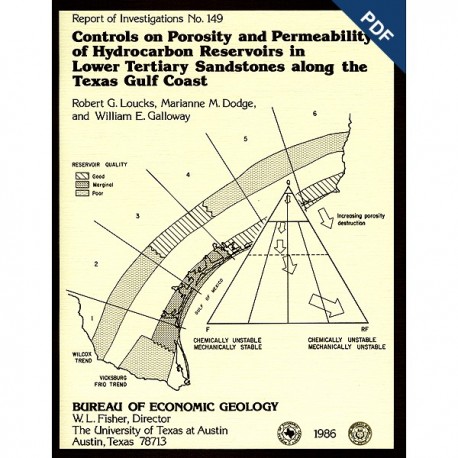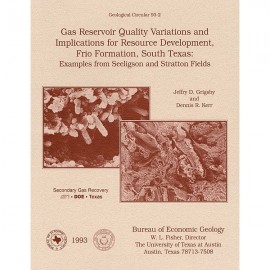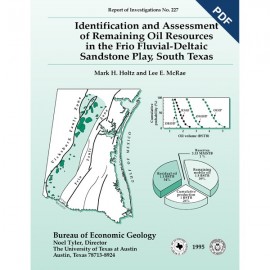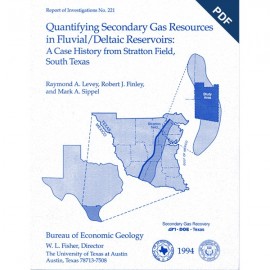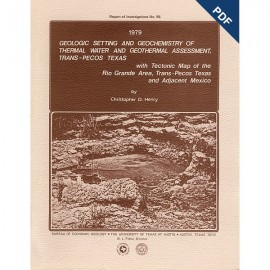Reports of Investigations
-
Books & Reports
- Reports of Investigations
- Guidebooks
- Udden Series
- Geological Circulars
- Down To Earth
- Atlases of Major Oil and Gas Reservoirs
- Texas Memorial Museum Publications
- Environmental Geologic Atlas of the Texas Coastal Zone
- Mineral Resource Circulars
- Other Reports
- Seminars and Workshops
- Handbooks
- Submerged Lands of Texas
- Symposia
- Annual Reports
- Open File Reports
-
Maps & Cross Sections
- Thematic Maps
- Miscellaneous Maps, Charts & Sections
- Geologic Atlas of Texas
- STATEMAP Project Maps
- Geologic Quadrangle Maps
- Cross Sections
- Highway Geology Map
- Energy and Mineral Resource Maps
- Shoreline Change and Other Posters
- Wilcox Group, East Texas, Geological / Hydrological Folios
- Bouguer Gravity Atlas of Texas
- River Basin Regional Studies
- Featured Maps
- Posters
- Teachers & the Public
-
Geological Society Publications
- Gulf Coast Association of Geological Societies
- Alabama Geological Society
- Austin Geological Society
- Corpus Christi Geological Society
- Houston Geological Society
- Lafayette Geological Society
- Mississippi Geological Society
- New Orleans Geological Society
- South Texas Geological Society
- GCS SEPM Publications
- Historic BEG & UT Series
Controls on Porosity and Permeability of Hydrocarbon Reservoirs in Lower Tertiary Sandstones... Digital Download
RI0149D
A free, digital version of this publication can be found on: Texas ScholarWorks
To purchase a print version (if available): RI0149
RI0149D. Controls on Porosity and Permeability of Hydrocarbon Reservoirs in Lower Tertiary Sandstones along the Texas Gulf Coast, by R. G. Loucks, M. M. Dodge, and W. E. Galloway. 78 p., 71 figs., 3 tables, 5 pls., 1 appendix, 1986. doi.org/10.23867/RI0149D. Downloadable PDF.
To purchase this publication in book format, please order RI0149.
ABSTRACT
Examination of porosity and permeability (reservoir quality) data, as determined by whole core, acoustic log, and petrographic analyses of lower Tertiary sandstones along the Texas Gulf Coast, made it possible to delineate areas most favorable for development of hydrocarbon reservoirs. Deep (about 3,350 m [11,000 ft] or greater) Wilcox sandstones exhibit no systematic regional reservoir-quality trends. Along the lower and parts of the middle and upper Texas Gulf Coast, deep Wilcox sandstones are tight, but in other parts of the middle and upper Texas Gulf Coast, porosity exists at depth. Yegua sandstone porosity is intermediate between that of the Vicksburg and Wilcox sandstones. Vicksburg sandstones have the poorest reservoir quality of all the deep sandstones. Frio sandstones improve systematically in reservoir quality from the lower to the upper Texas Gulf Coast owing to grain composition and geothermal gradient.
Wilcox sandstones are poorly to moderately sorted, fine-grained, quartzose lithic arkoses that become richer in quartz from the upper to the lower Texas Gulf Coast. Most rock fragments are metamorphic or volcanic. Yegua sandstones are moderately sorted, fine-grained, lithic arkoses to quartzose lithic arkoses. Volcanic and carbonate rock fragments are common along the lower Texas Gulf Coast, whereas volcanic and metamorphic rock fragments are common along the middle and the upper Texas Gulf Coast. Vicksburg sandstones are poorly sorted, fine-grained lithic arkoses. Rock fragments are mainly volcanic clasts containing lesser amounts of carbonate and minor amounts of metamorphic clasts. Frio sandstones range from poorly sorted, fine-grained, feldspathic litharenites to lithic arkoses along the lower Texas Gulf Coast to poorly sorted, fine-grained, quartzose lithic arkoses to subarkoses along the upper Texas Gulf Coast. Volcanic and carbonate rock fragments are common along the lower Texas Gulf Coast.
Although they vary in composition, lower Tertiary sandstones exhibit similar diagenetic sequences that may be idealized as follows:
Surface to shallow subsurface diagenesis (0 to 1,200 m+/- [0 to 4,000 ft+/-]) began with the formation of clay coats on framework grains, dissolution of feldspar, and replacement of feldspar by calcite. Minor amounts of kaolinite, feldspar overgrowths, and Fe-poor calcite were locally precipitated. Porosity was commonly reduced by compaction and cementation from an estimated original 40 percent to less than 30 percent.
Intermediate subsurface diagenesis (1,200 to 3,400 m+/- [4,000 to 11,000 ft+/-], involved dissolution of early-formed carbonate cements and subsequent cementation first by quartz overgrowths and later by carbonate cement. Cementation may have reduced porosity to 10 percent or less, but this trend could have been reversed by later dissolution of feldspar grains, rock fragments, and possibly carbonate cements. Porosity was restored in some sandstones to more than 30 percent, but some porosity was later reduced by cementation by kaolinite, Fe-rich dolomite, and ankerite.
Deep subsurface diagenesis (>3,350 m +/- [>11,000 ft+/-]) was a continuation of late-stage Fe-rich and Fe-poor carbonate cement precipitation. Plagioclase was albitized during this stage. Differences in intensity of diagenetic features that were related to changes in rock composition and geothermal gradient distinguish areas of high reservoir quality in the deep subsurface along the Texas Gulf Coast. Vicksburg and Frio reservoirs along the lower Texas Gulf Coast have extensive late-formed carbonate cements, whereas along the upper Texas Gulf Coast late-formed carbonate cements are minor. Wilcox reservoirs show no simple regional trend; quartz and carbonate are the dominant porosity-reducing cements, and their precipitation was governed by local chemical and physical conditions.
Keywords: diagenesis, geopressure, Gulf Coastal Plain, permeability, porosity, reservoir properties, reservoir rocks, sandstone, Tertiary, Texas
CONTENTS
ABSTRACT
INTRODUCTION
General statement
Objectives and scope of study
Methodology
REGIONAL GEOLOGY
RESERVOIR QUALITY
Sources of data
Porosity and permeability trends
Porosity by formation and area
REGIONAL CONTROLS ON RESERVOIR QUALITY
General statement
Effect of time on porosity
Effect of pressure on porosity
Effect of temperature on porosity
Mineralogy and diagenesis: controls on reservoir quality
General statement
General diagenetic sequence
Mineralogy and diagenesis: stratigraphic and geographic distribution of reservoir quality
Sandstone classification
Wilcox Group
Texture and mineralogy
Diagenesis
Reservoir quality
Yegua Formation
Texture and mineralogy
Diagenesis
Reservoir quality
Vicksburg Formation
Texture and mineralogy
Diagenesis Reservoir quality
Frio Formation
Texture and mineralogy
Diagenesis
Reservoir quality
Summary of reservoir quality in lower Tertiary Gulf Coast sandstones
PETROPHYSICAL PARAMETERS AND DIAGENESlS
Rock consolidation gradient from interval-transit-time plots
Regional variation in rock consolidation gradient
CONCLUSIONS
ACKNOWLEDGMENTS
REFERENCES
APPENDIX: WELL DATA
FIGURES
1. Stratigraphic chart of the Cenozoic Era, Texas Gulf Coast
2. Area of investigation
3. Distribution of whole core by area, unit, and depth
4. Location of wells with porosity and permeability data
5. Location of wells with acoustic logs
6. Depositional style of Cenozoic strata along the Texas Gulf Coast
7. Salt domes and major faults of the Gulf of Mexico region
8. Mean porosity versus depth from both whole core and sidewall core
9. Mean sandstone porosity versus depth from whole core analyses
10. Sandstone porosity versus depth from whole core analyses
11. Permeability versus depth from whole core analyses
12. Mean porosity versus depth for sandstones with and without clay matrix
13. Relation of porosity to permeability for Wilcox Group and Vicksburg and Frio Formations
14. Mean sandstone porosity versus depth by formation
15. Mean Wilcox sandstone porosity by area
16. Mean Frio sandstone porosity by area
17. Relation of porosity to depth of burial in late Cenozoic sands and sandstones and Cenozoic shales in the hydropressured zone and in the geopressured zone in the Louisiana Gulf Coast basin
18. Porosity loss relative to pressure gradient
19. Pressure at 3,050 m (10,000 ft) in the geopressured zone
20. Pressure at 3,660 m (12,500 ft) in the geopressured zone
21. Porosity versus corrected bottom-hole temperature for Wilcox sandstones
22. Porosity versus corrected bottom-hole temperature for Frio sandstones
23. Corrected temperature at 2,290 m (7,500 ft) in the hydropressured zone
24. Corrected temperature at 3,050 m (10,000 ft) (a) in the hydropressured zone and (b) in the geopressured zone
25. General pathways of porosity and interval transit time with depth
26. Secondary porosity as a percent of total porosity versus depth
27. General diagenetic stages with increasing depth of burial
28. Sandstone classification
29. Wilcox sandstone composition
30. Basic data for Wilcox sandstone composition by area
31. Distribution of sorting in Wilcox sandstones by area
32. Distribution of grain size in Wilcox sandstones by area
33. Wilcox sandstone rock fragment composition
34. Diagenetic events versus depth for Wilcox sandstones
35. Permeability versus depth by area for Wilcox Group
36. Secondary porosity as a percent of total porosity versus depth for Wilcox sandstones
37. Yegua sandstone composition
38. Basic data for Yegua sandstone composition by area
39. Distribution of sorting in Yegua sandstones by area
40. Distribution of grain size in Yegua sandstones by area
41. Yegua sandstone rock fragment composition
42. Diagenetic events versus depth for Yegua sandstones.
43. Secondary porosity as a percent of total porosity versus depth for Yegua sandstones
44. Vicksburg sandstone composition.
45. Basic data for Vicksburg sandstone composition by area
46. Distribution of sorting in Vicksburg sandstones by area
47. Distribution of grain size in Vicksburg sandstones by area
48. Source areas for sediments of the Vicksburg and Frio Formations
49. Vicksburg sandstone rock fragment composition
50. Diagenetic events versus depth for Vicksburg and Frio sandstones
51. Permeability versus depth by area for Vicksburg Formation
52. Secondary porosity as a percent of total porosity versus depth for Vicksburg sandstones
53. Frio sandstone composition
54. Basic data for Frio sandstone composition by area
55. Distribution of sorting in Frio sandstones by area
56. Distribution of grain size in Frio sandstones by area
57. Relation of percent quartz to average grain size for Frio sandstones along the Texas Gulf Coast
58. Frio sandstone rock fragment composition
59. Permeability versus depth by area for Frio Formation
60. Secondary porosity as a percent of total porosity versus depth for Frio sandstones
61. Packing proximity versus depth for Vicksburg sandstones from area 1 and Frio sandstones from areas 5 and 6
62. Interval transit time as a function of depth showing consolidation effect for Louisiana Tertiary sandstones
63. Sandstone interval transit time versus depth for the Coastal States and Greenbriar Ltd. 72 No. 1 Echols in Starr County
64. Sandstone interval transit time versus depth for the George Mitchell No. 1 Peschel in Austin County
65. Sandstone interval transit time versus depth for three wells in area 1 of the Vicksburg/Frio trend showing effect of formation changes
66. Sandstone interval transit time versus depth by area for the Vicksburg/ Frio trend
67. Basic data for plot of interval transit time versus depth for the Vicksburg/ Frio trend sandstone
68. Sandstone interval transit time versus depth by area for the Wilcox trend
69. Basic data for plot of interval transit time versus depth for the Wilcox trend sandstone
70. Potential for high-quality, deep reservoirs in lower Tertiary strata along the Texas Gulf Coast
71. Schematic porosity versus depth/ temperature curve for lower Tertiary sandstones showing relative significance of primary versus secondary porosity
TABLES
1. Porosity loss relative to pressure gradient, calculated using Atwater and Miller's data from south Louisiana
2. Porosity loss relative to pressure gradient for Wilcox and Frio sandstones along the onshore Texas Gulf Coast
3. Average geothermal gradients by area for the updip Wilcox and downdip Vicksburg/ Frio trends
PLATES
1. Criteria for recognition of secondary porosity
(a) Patchy remnants of Fe-rich carbonate cement
(b) Partial dissolution of a plagioclase grain
2. Criteria for recognition of secondary porosity
(a) Partial dissolution of a volcanic rock fragment forming secondary porosity
(b) Dissolution of feldspar grain forming honeycombed structure
3. Criteria for recognition of secondary porosity
(a) Almost complete dissolution of feldspar grain with a minor honeycombed structure and clay coat remaining
(b) Dissolved feldspars outlined by clay coat and partially filled with kaolinite cement
4. Criteria for recognition of secondary porosity.
(a) Sandstone showing oversized pore spaces resulting from dissolution of feldspars
(b) Embayment in quartz overgrowth
5. Generalized rock consolidation sequence with increasing depth for Tertiary formations of the Texas Gulf Coast
Citation
Loucks, R. G., Dodge, M. M., and Galloway, W. E., 1986, Controls on Porosity and Permeability of Hydrocarbon Reservoirs in Lower Tertiary Sandstones along the Texas Gulf Coast: The University of Texas at Austin, Bureau of Economic Geology, Report of Investigations No. 149, 78 p.
